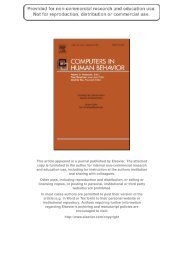Varnhagen.pdf
You also want an ePaper? Increase the reach of your titles
YUMPU automatically turns print PDFs into web optimized ePapers that Google loves.
730 C. K. <strong>Varnhagen</strong> et al.<br />
It is also efficient to dispense with capitalization and punctuation, so long as the<br />
message is clear. Pragmatic devices, such as emoticons, use of capitals for<br />
emphasis, and emotion words/acronyms, help users of instant messaging clarify<br />
meaning. In face to face conversation, emotion and attitude are expressed in facial<br />
expressions, such as smiling or frowning (Jakobson, 1960). In text, emotion must be<br />
made explicit; Stevenson & Shortis, (n.d.) argued that emoticons, and other<br />
paralinguistic pragmatic devices, such as use of capitalization for ‘‘shouting,’’ are<br />
unique adaptations for expressing emotion in text without providing lengthy written<br />
explanations. We found a number of cues to emotion, ranging from use of emotion<br />
words (e.g., hahaha) and acronyms (e.g., lol) to excessive use of punctuation (e.g.,<br />
!!!!) and upper case (e.g., WHAT) to express emotion.<br />
Typing quickly can lead to errors. Some errors have become so common that they<br />
may be becoming new language words themselves, such as the typographical error<br />
spelling for knwo, which now exists as an entry in the Urban Dictionary (http://<br />
www.urbandictionary.com). Surprisingly, we found few typographical errors or<br />
misspellings in our study, but misspellings were predicted by spelling ability. On the<br />
other hand, abbreviations, acronyms, letter or number words, and phonetic spellings<br />
are all short cuts that minimize typographical errors and misspellings in the first<br />
place.<br />
Our development of a taxonomy of short cuts, pragmatic devices, and errors has<br />
several important uses, including comparing new language use across different<br />
media, the acquisition of new language by children, and documenting the evolution<br />
of new language as we increasingly rely on text-based forms of communication.<br />
Investigating use of new language across different media, ranging from different<br />
forms of electronic communication programs, such as instant messaging, chat, and<br />
e-mail, to written work in school is important for understanding how people adapt<br />
language to serve different functions. As well, to dispel concerns that new language<br />
use in instant messaging is ruining children and adolescent’s ability to write essays<br />
and formal communications using conventional language (e.g., Lee, 2002), future<br />
research can examine intrusions (or lack thereof) of new language into classroom<br />
writing. Instead of becoming detrimental, instant messaging may actually encourage<br />
school writing; Spatafora (2008) argued that we may wish to use instant messaging<br />
for educational purposes and motivate school writing while, at the same time,<br />
building in instruction in conventional forms of writing.<br />
If new language in instant messaging is truly a new form of written communication,<br />
then our taxonomy is important for documenting the evolution and<br />
acquisition of this form of communication over time and over contexts, particularly<br />
when combined with ethnographic research designs as advocated by Jacobs (2004).<br />
Although we did not find any age effects in use of new language, we did have a<br />
relatively restricted range of adolescents. Future studies need to consider a broader<br />
range of youth. Most interesting would be a longitudinal study of children as they<br />
begin to use instant messaging.<br />
The literature is equivocal in terms of gender differences in instant messaging<br />
and the use of other forms of electronic communication, with Lee (2003) finding<br />
that female college students use more emoticons in instant messaging than do males<br />
and Huffaker and Calvert (2005) finding that adolescent males use more emoticons<br />
123
















